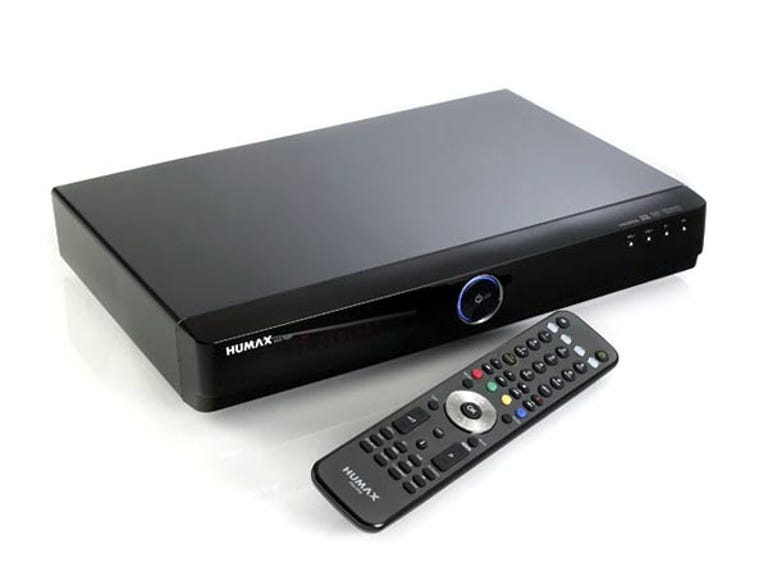 Why You Can Trust CNET
Why You Can Trust CNET Humax HDR-7500T review: Humax HDR-7500T
Humax's HDR-7500T is a solid performer if you're after a PVR, but for ease of use it's still got a long way to go to unseat TiVo.
Design
Humax's design of the HDR-7500T practically screams "I'm a PVR" at you. This is not necessarily a bad thing; it's just that it doesn't have what could be called a particularly memorable or interesting visual design, with a standard LED display next to a glowing ring that indicates its current recording status. It's inevitably decked out in a piano-black finish, and while this might look good on a sales floor, in a home environment it's an invitation for fingerprint smudges and dust collection.
The Good
The Bad
The Bottom Line
The HDR-7500T's remote control is an exceptionally busy little creature, with buttons to cover most features of the PVR, as well as a number of function buttons to cover its use as a universal remote control.
Features
There are two models of the HDR-7500T to pick from, although the only key difference is the in-built storage; AU$449 buys you the 500GB model, while AU$549 scores you a 1TB unit. It covers the standard bases of a high-end PVR, as it's capable of dual-channel recording via either Humax's own EPG — which is just the free-to-air digital EPG with a fresh coating of paint on it — or IceTV. There's a trial of IceTV provided with the unit, as well as the offer for a lifetime subscription for AU$99. IceTV doesn't just provide a slightly longer EPG for your money; it also unlocks the ability to manage season pass-style recording for favourite programs. We'd say factor in the AU$99 IceTV cost into your Humax buying decision, as it's a much better unit with IceTV than without it.
The HDR-7500T is also Ethernet and Wi-Fi (via an optional adapter, sold separately) ready for both streaming programs from a network share and some limited Smart TV-style apps. At launch, these are limited to iView, Youtube, Wiki@TV and Picasa. It's claimed they'll be updated and improved over time, but we can only assess what you'd get right now if you bought one. On the bright side, the box isn't Freeview branded, and that means that ad skipping is supported in a variety of skip lengths.
Performance
Setting up the Humax involved the usual run of setting locale, network and scanning for stations, which the box did without any real complaint. It took a little while to pick up either the Humax or IceTV EPG guides; that tallies with what we've seen with the free-to-air EPG, which is often extremely limited and sometimes flat out wrong. Again, it's worth considering these boxes as being essentially AU$99 more than the RRP, if only because IceTV does expand its functionality quite a bit.
The PVR basics are handled well, but we struggled to intuitively learn the way the Humax logic flow works. The obvious competitor in this space would be TiVo, and if there's one lesson that Humax could learn from TiVo it's that pleasurable TV watching is essentially a lazy activity. You don't want to have to sort out if the iView app is via "TV Portal" or "Media", or if the DLNA network streaming comes via hitting "Menu" or any of the red, green, yellow or blue buttons. Yes, you can learn this stuff over time, but it means you're always looking at the remote to find the right button, rather than at the screen.
Of the included applications, iView's the clear current star; while many streaming boxes will do YouTube, having to navigate via on-screen keyboard grows very old very fast, whereas iView's clickable interface works well and requires minimal remote control staring. It'll be interesting to see how dedicated to new applications Humax actually is; while it's talking a big game at launch, we've seen many boxes that promised big things via updates fail to deliver.
We hit some genuinely odd issues streaming media from a Netgear ReadyNAS NV+. For whatever reason, once we got beyond about three directory levels deep, the HDR-7500T would select the folder above the one we'd highlighted 90 per cent of the time. It wasn't 100 per cent consistent — at least you could work around that — and we're not sure if it's the NAS or PVR at fault, but we've not hit that particular problem with other streaming boxes in the past. Humax's claim is that the updates come through at 4am via the network for the HDR-7500T; hopefully that's one intermittent bug that'll be squashed soon.
Conclusion
The HDR-7500T is a decent dual-channel PVR with in-built DLNA and at least a smattering of apps that could grow into a larger library over time — but we can only review what's placed in front of us, not what could be. There's no shortage of competing units from companies such as TiVo or Topfield, and Humax needs to sort out easier remote navigation and more stable DLNA network usage.


